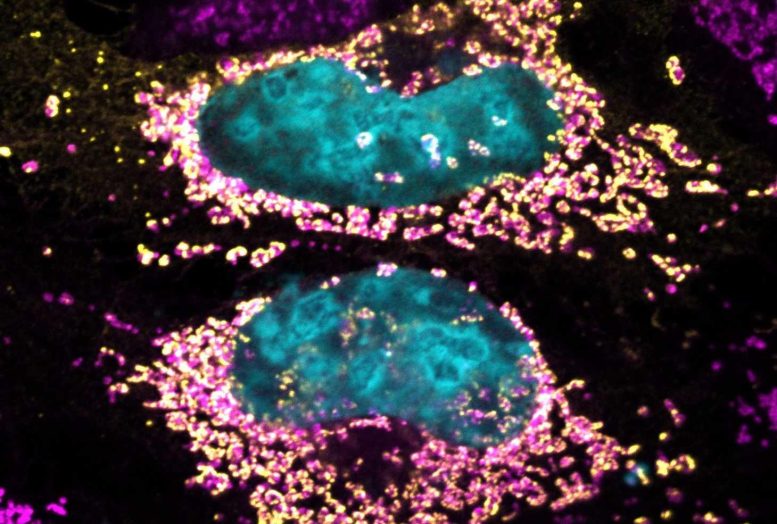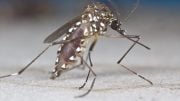
Human cells showing cell nuclei (cyan), mitochondria (magenta), and the Coxiella burnetii protein MceF (yellow). The figure evidences the co-location of MceF with cellular mitochondria. Credit: Robson Kriiger Loterio
Researchers have discovered a previously unidentified protein with antioxidant properties produced by Coxiella burnetii, a Gram-negative intracellular bacterium. This breakthrough suggests potential new treatments for autoimmune diseases and cancer.
Researchers at the University of São Paulo, in collaboration with Australian colleagues, have discovered a unique bacterial protein capable of keeping human cells healthy even when the cells have a heavy bacterial burden. This breakthrough holds the potential for developing new treatments for various diseases linked to mitochondrial dysfunction, including cancer and autoimmune disorders. Mitochondria, the cell’s powerhouses, are essential for providing the energy required for cellular biochemical reactions.
An article on the study is published in the journal PNAS. The researchers analyzed more than 130 proteins released by Coxiella burnetii when this bacterium invades host cells and found at least one to be capable of prolonging cell longevity by acting directly on mitochondria.
After invading host cells, C. burnetii releases a hitherto unknown protein, which the authors call mitochondrial coxiella effector F (MceF). MceF interacts with glutathione peroxidase 4 (GPX4), an anti-oxidant enzyme located in the mitochondria, to improve mitochondrial function by promoting an anti-oxidizing effect that averts cell damage and death, which may occur when pathogens replicate inside mammalian cells.
“C. burnetii uses various strategies to prevent the death of invaded cells and multiply inside them. One is the modulation of GPX4 by MceF, the mechanism we discovered and reported in this article. Reallocation of these proteins in cellular mitochondria enables mammalian cells to live longer even when they’re infected with a very large bacterial burden,” said Dario Zamboni, one of the corresponding authors of the article and a professor at the Ribeirão Preto Medical School (FMRP-USP).
The study was conducted at the Center for Research on Inflammatory Diseases (CRID), one of FAPESP’s Research, Innovation and Dissemination Centers (RIDCs), in collaboration with Hayley Newton, a professor at Monash University in Australia. Funding was also provided by FAPESP via a project coordinated by Zamboni.
“Basically, we discovered a strategy used by C. burnetii to keep cells healthy for longer while replicating intensely. We found that its protein MceF redirects GPX4 to the mitochondria, where it acts as a potent antioxidant, detoxifying the infected cell and preventing cell components from aging, while allowing replication of the bacterium,” said Robson Kriiger Loterio, first author of the article, which derived from his Ph.D. research.
Cell biologist
C. burnetii is the causative agent of a serious infection called Q fever, a relatively common but infrequently diagnosed zoonosis. According to the authors, agricultural outbreaks are “an increasingly significant economic and public health burden”.
The bacterium causes atypical pneumonia in humans and coxiellosis in some animals, such as cattle, sheep, and goats. Zamboni explained that it is highly adapted to invade and control macrophages and monocytes – white blood cells that are part of the organism’s front-line immune defense – inhibiting the host’s responses to the infection.
“The interest of studying this bacterium in depth lies precisely in its ability to subvert cell functions. Unlike other bacteria, which cause disease only when they multiply to reach large numbers, a single C. burnetii is enough to make a healthy person sick. So it acts efficiently to modulate the cells it invades. We refer to it jokingly as a brilliant cell biologist because of this ability to modulate everything in host cells,” Zamboni said.
Another interesting aspect of C. burnetii, he added, is that it replicates in cells for about a week. For comparison, Salmonella, which causes severe food poisoning, causes the death of host cells in less than 24 hours.
“Observing C. burnetii is a good way to learn about how cells function. In the case of this study, it helped us understand how to treat mitochondrial dysfunction, and provided insights on programmed cell death in humans,” he said.
To analyze the bacterium’s capacity to subvert macrophages and act directly on mitochondria, the researchers conducted in vitro assays and experiments involving larvae of the Greater wax moth (Galleria mellonella). In this first stage of the study, they investigated more than 80 novel proteins from C. burnettii with the potential to interact with host cells and subvert their functioning. “We ended up focusing on MceF because it acts directly on mitochondria, which play a key role in the process of cell death,” Zamboni said.
The group will now continue the research on two fronts, one aiming at a deeper understanding of other proteins of interest, and the other involving biochemical studies to find out more about how MceF influences GPX4.
“The nice thing about this research is that by investigating a bacterium we’re learning a lot about cell signaling, cell death, and novel ways of reversing mitochondrial dysfunction. We don’t need to invent a new technique. The process already occurs during the bacterium’s interaction with host cells,” he said.
Reference: “Coxiella co-opts the Glutathione Peroxidase 4 to protect the host cell from oxidative stress–induced cell death” by Robson K. Loterio, David R. Thomas, Warrison Andrade, Yi Wei Lee, Leonardo L. Santos, Danielle P. A. Mascarenhas, Thiago M. Steiner, Jéssica Chiaratto, Laura F. Fielden, Leticia Lopes, Lauren E. Bird, Gustavo H. Goldman, Diana Stojanovski, Nichollas E. Scott, Dario S. Zamboni and Hayley J. Newton, 28 August 2023, Proceedings of the National Academy of Sciences.
DOI: 10.1073/pnas.2308752120









Can you provide more information about Q fever? What organ is it first reported to effect or be determined as first site of infection?
This is wonderful I’m a traditional healer